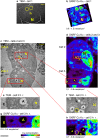Imaging trace element distributions in single organelles and subcellular features
- PMID: 26911251
- PMCID: PMC4766485
- DOI: 10.1038/srep21437
Imaging trace element distributions in single organelles and subcellular features
Abstract
The distributions of chemical elements within cells are of prime importance in a wide range of basic and applied biochemical research. An example is the role of the subcellular Zn distribution in Zn homeostasis in insulin producing pancreatic beta cells and the development of type 2 diabetes mellitus. We combined transmission electron microscopy with micro- and nano-synchrotron X-ray fluorescence to image unequivocally for the first time, to the best of our knowledge, the natural elemental distributions, including those of trace elements, in single organelles and other subcellular features. Detected elements include Cl, K, Ca, Co, Ni, Cu, Zn and Cd (which some cells were supplemented with). Cell samples were prepared by a technique that minimally affects the natural elemental concentrations and distributions, and without using fluorescent indicators. It could likely be applied to all cell types and provide new biochemical insights at the single organelle level not available from organelle population level studies.
Figures


References
-
- Lee S. M., Chen H., Dettmer C. M., O’Halloran T. V. & Nguyen S. T. Polymer-caged lipsomes: a pH-responsive delivery system with high stability. Journal of the American Chemical Society 129, 15096–15097 (2007). - PubMed
-
- Kim B. E., Nevitt T. & Thiele D. J. Mechanisms for copper acquisition, distribution and regulation. Nat Chem Biol 4, 176–185 (2008). - PubMed
Publication types
MeSH terms
Substances
Grants and funding
LinkOut - more resources
Full Text Sources
Other Literature Sources

